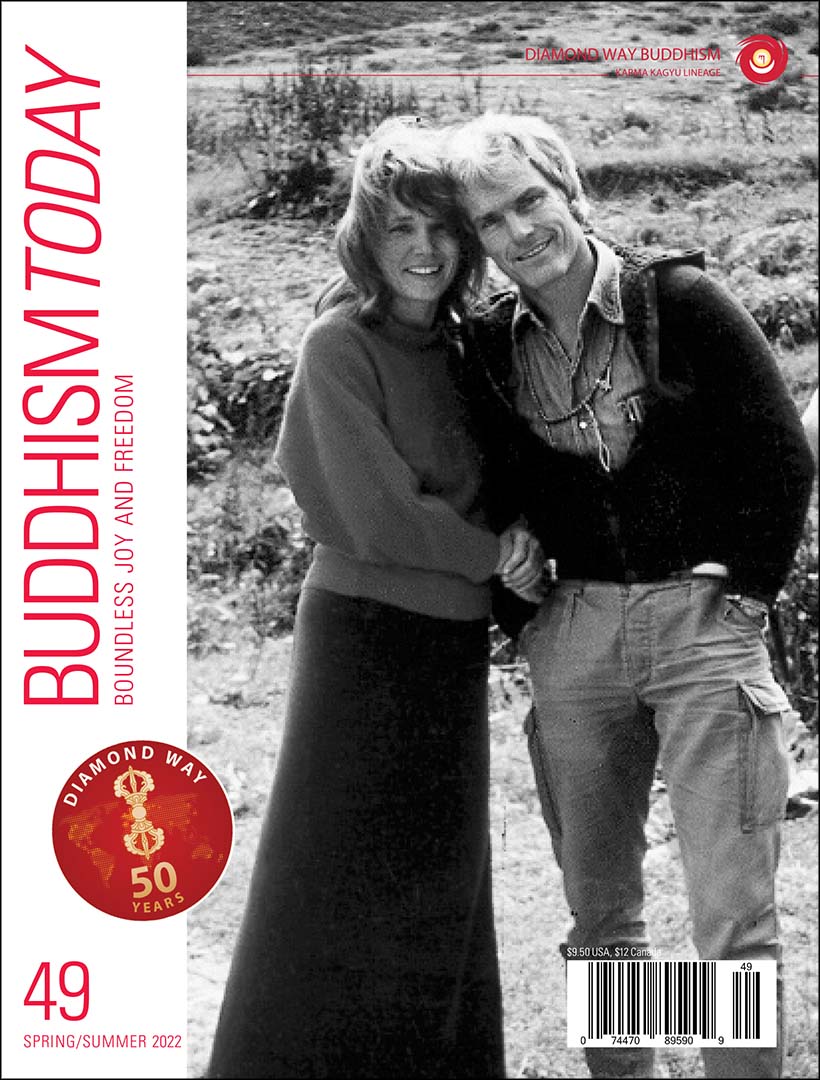Boundless Awakening: The Heart of Buddhist Meditation
by Shamar Rinpoche | Issue 34
Before going into the actual topic, I would like to draw your attention to the fact that the limited medium of language is inadequate to convey the actual experience of even the most fundamental forms of meditation and mindfulness. The concepts of language are based on common experience. Words such as “hot” and “cold,” for example, communicate a fairly precise meaning that everyone can agree upon because everyone has experienced these sensations of heat and cold through direct physical contact at one time or another. This process is different with inner experiences. Inevitably, we are facing a certain dilemma here in that we try to communicate ineffable experiences, such as states of awareness arising in meditation, through language. Therefore, how can we ever be certain that the terms we are applying bring about a certain degree of mutual understanding?
The discussion of philosophical topics is basically confined within the boundaries of shared inner experience, with no external reference point to agree upon. While it is true that over the preceding centuries in languages such as Sanskrit, Pali, Mandarin, and Tibetan a great variety of philosophical Buddhist terms were developed by scholars and meditators, to understand the actual meaning of this terminology requires a substantial background of information and familiar experiences.
I would like to share one example with you to illustrate this point: one key term in Tibetan Buddhism is “ro chig” (Tib. ro gcig), which literally translates as “one taste.” But what the term means is that, on the basis of true insight into the nature of reality, everything outer and inner is realized in the same manner; this realization, once attained, is unchanging and thus means that all things are perceived evenly or equally. It is one of many levels of accomplishment that can be attained through the practice of “lan chig kye chor” (Tib. lhan cig skyes sbyor), i.e. the “practice of simultaneity.” Obviously, “one taste” is a metaphor for a specific mental experience and does not describe a certain sensation of taste. By means of this term, a person who has experienced the awareness of “one taste” can communicate with someone else who has had the same experience, at least to a certain extent. Yet, for those who don’t have this experience, the term most likely remains abstract and difficult to grasp.
This example shows that the respective Buddhist terminology may function as an adequate means of communication between people who share the same experience of meditative insight, but in general, use of it tends to become vague, capable of providing only a rough outline of the intended meaning.
Yet, we do not have many means of communication other than language. Therefore, I will attempt to share my thoughts on Buddhist meditation as well as possible.
Buddhist meditation is comprised of two aspects: calm abiding and insight… The meditation of calm abiding engenders a well-balanced, peaceful, and joyful state of mind. On this basis, the meditation of insight enables us to gain a deep and experience-based knowledge of the true nature of ourselves and of the world of appearances. A main feature of both of these practices is mindfulness, which enables us to fully appreciate the preciousness of each moment of our life.
The ability to remain in a state of complete absorption is considered extremely advanced, but even in the early stages of meditation you can learn to sit quietly and be aware of your mind, observing the flow of arising and passing thoughts that are like movements of fleeting clouds in a clear sky.
At first the meditator’s mind is like a wild horse yet, by engaging in the consistent practice of calm abiding meditation, it can gradually become tame. Eventually, the mind becomes clear and completely free of agitation. In some instruction texts, the agitation in the mind is first compared to a cascading waterfall, later with the gently flowing currents of a broad river, and finally with the still water of a clear lake on a day without wind.
In choosing a teacher, you should understand that the person should be well-educated and experienced in meditation, endowed with a mind of renunciation, patient, and full of care for the student. The teacher should be able to support the student skillfully, without being harsh or discouraging. I cannot overemphasize the importance of finding a good teacher.
Practicing calm abiding meditation is the cause for achieving equanimity and peace. Continuous training allows for the experience of a state of calmness in which the mind is capable of a clear focus, being aware of its nature as joy, clarity, and emptiness. For a practitioner who is not attached to these experiences, the gateway for coming into contact with the absolute nature of the mind opens, enabling him to reduce the habit of imposing the mistaken concept of a truly substantial, inherent existence on mind itself. With continuous practice, the potential for these capacities to increase is limitless. It is like a caterpillar emerging from the cocoon as a butterfly… However, as great as such meditation states of calm abiding may be, they do not transcend samsaric states of mind, and thus do not bring about ultimate liberation from cyclic existence. They are not comparable to a buddha’s awakened state. For someone who wishes to liberate himself from cyclic existence and to benefit others compassionately, the next step is therefore indispensable: the developing of insight.
From the Buddhist point of view, mind is not of a physical nature because it has qualities other than those that are attributed to the brain, which can be viewed and touched. The brain merely serves as a physical substrate for the processes of cognition. The mind as such, however, is not the brain. Yet, mind is not nothing, but is a living experience which is vivid and dynamic. Mind’s actual nature is clear, empty, and unobstructed.
Taking into account the shortness of life, it is possible to have a general interest in meditation and to understand the urge of spiritual development. Yet, it is up to everyone individually to really decide that it is truly important for oneself.





